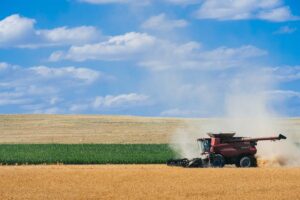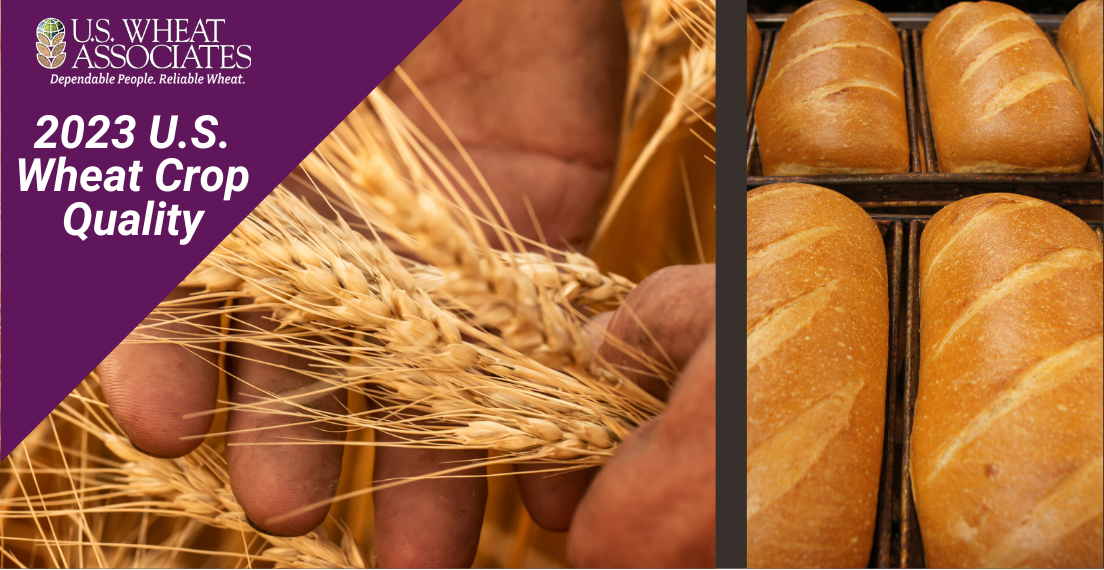A much larger 2023 U.S. hard white (HW) wheat crop also shows acceptable quality performance in milling, dough properties and finished products like pan breads, Asian noodles, and steamed breads. The Pacific Northwest (PNW), California and Southern Plains composites all show acceptable to excellent bread baking potential according to respective protein contents. Performance in Asian noodle applications and steamed breads is somewhat more variable.

2023 Crop Highlights
Planted and harvested area for the 2023 HW crop reflect high abandonment in the Southern Plains due to drought. USDA estimates total HW planted area at 616,800 acres and harvested area at 473,520 acres, with abandonment of 23% compared to 15% in 2022.
Production was supported by late-season rain in Colorado and Nebraska, and much better growing conditions in the PNW. USDA’s estimate of total winter and spring HW wheat is 0.62 million metric tons (MMT) for 2023, 32% more than 0.47 MMT in 2022.
The grade for low- and medium-protein composites for California and the Southern Plains grade as U.S. No. 1. Very high protein composites from the PNW and Southern Plains grade as U.S. No. 2 primarily due to lower test weights
Test weights range from 59.3 to 64.4 lb/bu (78.0 to 84.6 kg/hl), a wider spread than in the 2022 crop.
Protein contents range from 10.8 to 13.7% (12% mb) with wheat moisture ranging from 9.9% to 12.8%.
1,000 kernel weights are equal to or greater than 30.0 g except for the low-protein Southern Plains composite at 29.6 g.
Falling number values are equal to or greater than 338 sec for all composites.
Buhler Laboratory Mill straight-grade flour extractions range from 69.8 to 70.6% on a tempered wheat weight basis, L* values (whiteness) from 91.6 to 92.4, and flour ash 0.42 to 0.50% (14% mb). Flour extractions should not be compared to previous years as the calculation has shifted from a total product weight basis to a tempered wheat weight basis. Commercial mills should see better extractions, although some adjustments may be necessary for portions of the crop with lower test weights and 1,000 kernel weights.
Flour wet gluten contents range 23.3 to 33.9% depending on protein content.
Starch pasting properties including amylograph and RVA peak viscosities range from 615 BU/2455 cP to 834 BU/2881 cP and indicate the crop will produce noodles with acceptable texture.
Dough properties show this year’s crop has lower water absorption values, weaker mixing properties, and less extensibility compared to last year.
Baking evaluation for all composites shows acceptable to excellent baking performance relative to protein content, with bake absorptions in the range of 62.6 to 68.5%, loaf volumes of 773 to 1026 cc, and crumb grain and texture scores that are similar to or better than a typical hard red winter (HRW) flour.
For Chinese white salted noodle performance, L* values are acceptable for all composites except the PNW and Southern Plains very high protein composites. The sensory color stability scores are excellent for the California medium protein composite with all other composites rating as poor. Using 60% extraction patent flour is recommended to improve noodle color while maintaining noodle texture. Cooked noodle texture is softer than the control for all composites primarily due to lower starch pasting viscosities and water absorptions than last year.
Chinese yellow alkaline noodle L* values are similar or better than the control for parboiled noodles from the California and Southern Plains composites. Cooked noodle texture is softer for all composites primarily due to lower starch pasting viscosities and water absorptions compared to last year.
Steamed bread results show most composites have acceptable specific volumes. Total scores are lower than the control flour due to smaller volumes, tighter and yellower internal crumbs, and surface blisters. Blending 25% soft white (SW) flour with high-protein HW flour may improve overall steamed bread quality.


